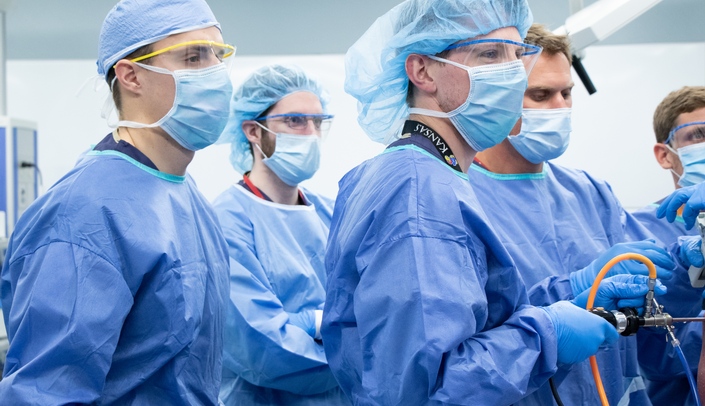The UNMC community officially celebrated the dedication of the Dr. Edwin G. & Dorothy Balbach Davis Global Center (Davis Global Center) in October.
This state-of-the-art facility houses iEXCEL (Interprofessional Experiential Center for Enduring Learning) — a transformative model for health care education, training and research that incorporates advanced simulation and visualization technologies in realistic, simulated health care settings to improve the outcomes of patient care. Through iEXCEL, UNMC will accelerate the adoption of simulation and visualization technology to reshape the way in which health care education is delivered.
The Davis Global Center provides realistic replicated health care settings in which teams can practice and experiment safely. This includes opportunities for training to competency before encountering real-life patient care and emergency response situations; surgical skills procedure rooms/operating bays with fresh tissue simulation for practicing high-level, complex patient care procedures; 3D, augmented/virtual reality (AR/VR) and holographic technologies to help transform learning, teaching, training and research; and collaboration with other disciplines, especially STEAM (science, technology, engineering, arts and mathematics) initiatives.
Hip simulation
The Department of Orthopaedic Surgery and Rehabilitation hosted Dr. Joel Matta and Dr. Raymond Kim from Steadman Clinic in Vail, Colorado, for an October 23 anterior approach cadaver lab.
Dr. Kim is one of the world’s leading hip and knee surgeons, specializing in direct anterior hip surgery. Dr. Matta is a renowned orthopaedic surgeon with expertise in hip and pelvic reconstruction. He was the founder of the anterior approach for hip replacement surgery.
The purpose of the lab was to have these surgeons share with the residency program their expertise in direct anterior hip replacement surgery and periacetabular osteotomies. Nearly every resident was present at this lab.
Dr. Matta began the day with a presentation about the history of direct anterior hip replacement, followed by Dr. Kim’s discussion of a different technique (off table) for doing direct anterior hip replacements.
Dr. Matta gave a demonstration on direct anterior hip replacement and showed how to use computer-assisted navigation with component positioning.
Residents performed direct anterior hip surgery on five cadaveric specimens, thanks to sponsors DonJoy Orthopaedics and DePuy, who provided instruments, implants and funding.
Adult reconstructive faculty were present to help facilitate education, including Kevin Garvin, MD, Curtis Hartman, MD, Beau Kildow, MD and Beau Konigsberg, MD.
"This was a rare and very fortunate educational event to have these two surgeons demonstrate and help teach residents this technique in hip replacement surgery," said Dr. Kildow. "We had many compliments about the iEXCEL lab. it truly is state-of-the-art."
